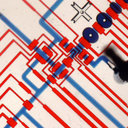Fatigue and human umbilical cord stem cell seeding characteristics of calcium phosphate-chitosan-biodegradable fiber scaffolds.
Keywords
Abstract
Calcium phosphate cement (CPC) has in situ-setting ability and bioactivity, but the brittleness and low strength limit CPC to only non-load-bearing bone repairs. Human umbilical cord mesenchymal stem cells (hUCMSCs) can be harvested without an invasive procedure required for the commonly studied bone marrow MSCs. However, little has been reported on hUCMSC delivery via bioactive scaffolds for bone tissue engineering. The objectives of this study were to develop CPC scaffolds with improved resistance to fatigue and fracture, and to investigate hUCMSC delivery for bone tissue engineering. In fast fracture, CPC with 15% chitosan and 20% polyglactin fibers (CPC-chitosan-fiber scaffold) had flexural strength of 26mPa, higher than 10mPa for CPC control (p<0.05). In cyclic loading, CPC-chitosan-fiber specimens that survived 2x10(6) cycles had the maximum stress of 10MPa, compared to 5MPa of CPC control. CPC-chitosan-fiber specimens that failed after multiple cycles had a mean stress-to-failure of 9MPa, compared to 5.8MPa for CPC control (p<0.05). hUCMSCs showed excellent viability when seeded on CPC and CPC-chitosan-fiber scaffolds. The percentage of live cells reached 96-99%. Cell density was about 300cells/mm(2) at day 1; it proliferated to 700cells/mm(2) at day 4. Wst-1 assay showed that the stronger CPC-chitosan-fiber scaffold had hUCMSC viability that matched the CPC control (p>0.1). In summary, this study showed that chitosan and polyglactin fibers substantially increased the fatigue resistance of CPC, and that hUCMSCs had excellent proliferation and viability on the scaffolds.


